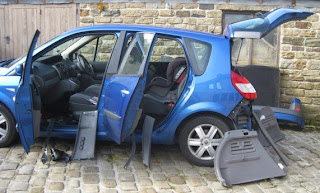A socket in time saves hours

Sometimes I wonder about the competence of car designers. There's always some glaringly inept features which seem to have got by the testing process, whether this is in the usability or the fixability (to adjust the fan belt on one car I owned, meant cutting a hole in the inner wing panel). I've just been fitting a towbar to my Renault. Holes were already drilled for the bar to be bolted to the main chassis and apart from having to grind off some extraneous metal (and tapping out a hole which hadn't been threaded properly) it went quite well.
However, reading the fitting instructions for the wiring hinted that this part of the process might not be so straightforward. In the olden days, one just snapped on a scotchblock to each of the wires to the lights (rear, indicators etc) and fed the wire to the towbar socket. A matter of minutes. Now, with the relays, bus systems and ICUs of modern cars, this is not possible. So I purchased the fabricated 'plug in' wiring for my particular make & model and expected to plug it in. The first step was to remove the lining panels in the rear and then, surprisingly the lower panels along the leftside to the front. It turns out that one has to run a wire all the way from the rear to the battery at the front! Huh? Not only is is neigh impossible to get a wire into the engine compartment (I used the bonnet release wire to drag through the wire) but threading it through the sills was a nightmare. Now, come on Renault designers ... you drilled holes in the chassis and even a pushout plate to feed the wires out to the towbar socket, but failed to add a power wire to drive the electronics necessary to install the trailer lighting. I was not impressed!

0 Comments:
Post a Comment
<< Home